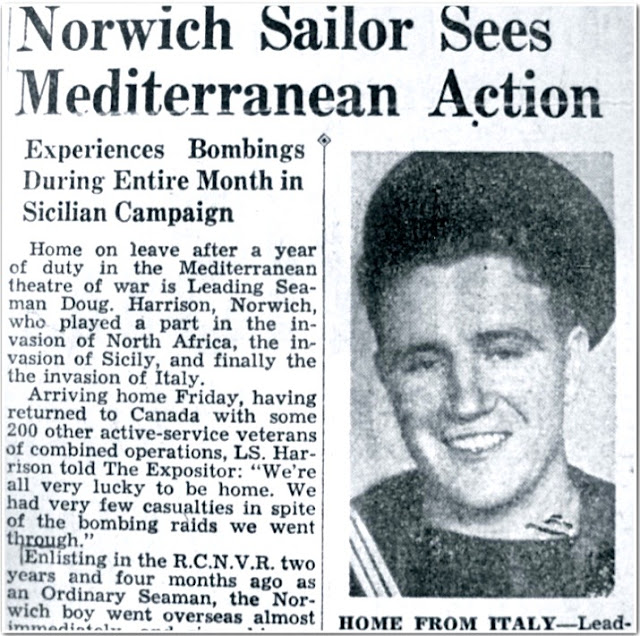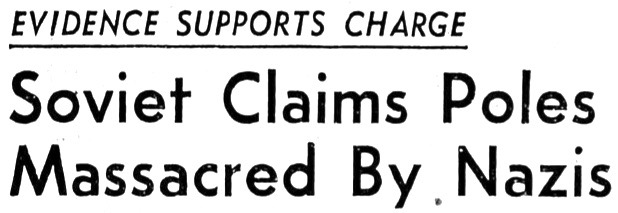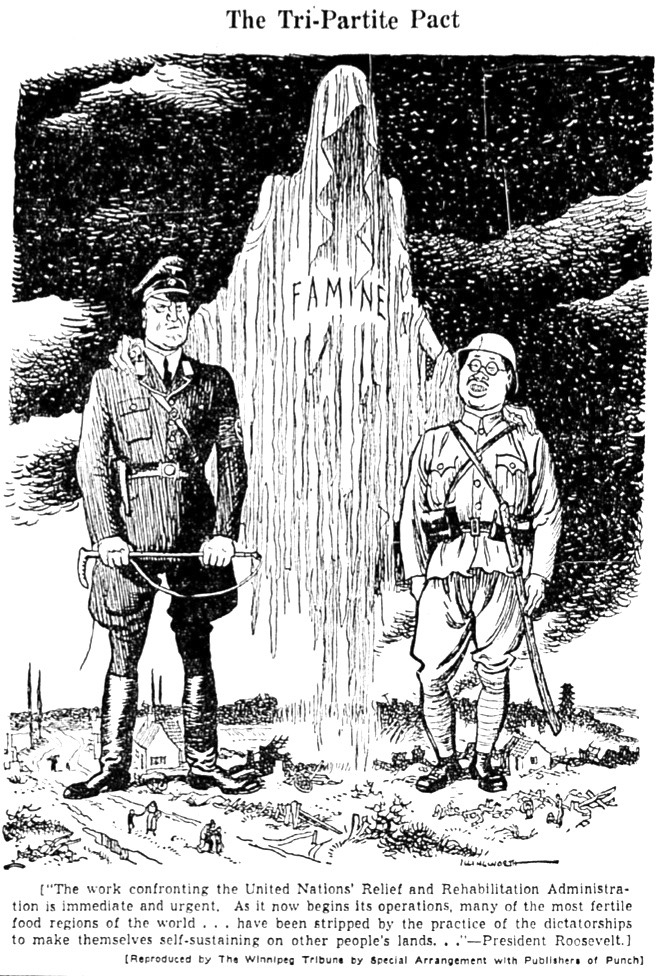Anzio Beachhead Expands; Landing Craft (for) Tanks Indispensable
The Canadians Move Up; Navy Effort Praised; Hospital Ship Sunk!
 HMHS Talamba: Bombed and sunk off Syracuse July 1943, during the landings
HMHS Talamba: Bombed and sunk off Syracuse July 1943, during the landingsin Sicily. Attacked even though fully illuminated and showing red cross markings.
More details Follow with news from Jan. 26, 1944 below. Photo - TyneBuiltShips Introduction:
The Canadian Navy - particularly those who volunteered for Combined Operations Command without really knowing what they were doing back then, i.e., getting into, in the late fall of 1941 - may be involved in a few aspects of the lengthy entry of news bites that follow, again without all of them really knowing where they fit in, or all knowing the significant actions in which they would participate.
Regular readers know that the 950 - 1,000 members of RCNVR (along with my father) who actually volunteered for landing craft duty (associated with operations beginning with the Dieppe Raid) when they joined Combined Operations - innocently and enthusiastically - are my chief interest on this blog/website... and I'll find ways to fit them in whenever and wherever I can.
Call it a bias, a leaning, a desire to follow faint footsteps revealed to me in my father's hand-written memoirs... but many news items I peruse on microfiche, or on hard copies, directly or indirectly can be link to my chief interest - Canadians in Combined Ops.
For example, the photo below is of a ball team. If one looks closely at the crest on the ball jackets, one will see an insignia that closely resembles the Combined Operations insignia. Is there a connection to Canadians in Combined Ops, WW2?
Yes, and a rare one.
Navy ball team, 1944 or 1945. Perhaps at Lewis Park, Courtenay, B.C.
Combined Ops crests have rifle pointing left of wearer, early version.
Early version, shoulder patch, with Combined Operations insignia
Later version of Comb. Ops insignia, worn by Canadian beach Commandos.
Rifle points to the right of wearer if on a jacket crest.
Many members of the Navy ball team were members of RCNVR and Combined Operations, and after two years service overseas (having participated in actions from Dieppe Raid (Aug. 1942) to invasion of Italy (beginning Sept. 1943) returned to Canada in December 1943.
Before volunteering for further duty (or being placed, e.g., via General Service' (?)) on Vancouver Island, some were scouted and nabbed by newspaper reporters for interviews. Earlier in this series of posts (re Editor's Research) I mentioned I would look for such news articles or interviews and I have one on file, re my father (in front row of baseball team photo, centre; Leading Seaman, Coxswain, RCNVR, Combined Ops).
The following newspaper article appeared in The Brantford Expositor likely during January - February 1944:
Caption: HOME FROM ITALY - Leading Seaman Doug Harrison, Norwich, who is home on leave after two years of active service on naval and combined operations overseas. He played a part in the successive invasions of North Africa, Sicily and Italy, and came through many heavy bombings. (Staff photo from The Brantford Expositor, 1944)
NORWICH SAILOR SEES MEDITERRANEAN ACTION
Home on leave after a year of duty in the Mediterranean theatre of war is Leading Seaman Doug Harrison, Norwich, who played a part in the invasion of Sicily, and finally the invasion of Italy. Arriving home Friday, having returned to Canada with some 200 other active-service veterans of combined operations, LS. Harrison told The Expositor: “We’re all very lucky to be home. We had very few casualties in spite of the bombing raids we went through.”
Enlisting in the R.C.N.V.R. two years and four months ago as an Ordinary Seaman, the Norwich boy went overseas almost immediately, and since his arrival in Britain he has been on loan to the Royal Navy. Both in training and in subsequent operations, his duties have been to see that invasion barges “get the goods to the soldiers at the right time, on the right beach.” His reference to “goods,” he explained, meant food, ammunition, trucks, and every other variety of war supplies.
NORTH AFRICA “EASY”
His share in the North African campaign was “quite easy,” he said. His point of invasion was at Arzeu, a short distance from Oran, on the Algerian coast. That was in November of last year, and it was his first operation after a year of training.
“I missed going to Dieppe by just one day,” he said. He had been on leave, and returned to duty just as the Dieppe casualty lists were coming in. Seven of his combined operations colleagues failed to come back from that cross-Channel venture.
SICILY “PLENTY HOT”
The Sicilian invasion he described as plenty hot. “We had 72 air raids in 36 hours,” he said. “We were bombed for three or four hours at a stretch, every night and every morning for a month, from the time the invasion started July 10.”
“We found the people of Sicily in bad condition, nearly starving. We practically kept them, with our own food. I saw boys 19 years old, only as big as Canadian boys of 11 or 12. They were begging for food all the time.”
EASY AGAIN
The Italian campaign was “easy,” so far as his share of the invasion was concerned, he said. “There was nothing to it. It was just a matter of walking in and taking over, after a 55-minute bombardment of Reggio Calabria, on the toe of the Italian boot, by naval guns and rocket guns.”
Leading Seaman Harrison, who drove a truck for the Norwich Co-operative before enlisting for naval service at the age of 20, is the son of Mrs. Alice Harrison, Norwich. He has a brother, Corporal Roland Harrison, in the R.C.A.F., stationed at No. 5 Service Flying training school, Brantford.
The Canadians overseas are doing a great job, he said. Omitting the navy for evident reasons of modesty, he had high praise for the Canadian Army and the R.C.A.F. “In my estimation the Canadian Army is the best in the world,” he said.
“WRITE TO THE BOYS”
“Anybody who has relatives overseas should write lots of letters,” he advised. “The Canadian boys like to get mail. It’s as welcome as pay day - in fact, in Italy it’s even more welcome because they can’t spend money there.”
He saw many active servicemen from Brantford, Norwich, and other points in this district. “They’re a good-looking bunch of lads, husky boys, and all tanned up,” he said.
LS. Harrison expects to return overseas on completion of his leave at home. He said he would not commit himself by making any prediction as to the length of the war, as the enemy was “a pretty tough customer, and will take a lot of beating.”
Editor's Note - As he and his many mates returned home (aboard Aquitania) in December, talk was likely about "where to next?" My father, like most of the other sailors, expected "to return overseas" once leave had expired. Exact details about how scores of sailors ended up on Vancouver Island are not known at this time. As my search continues for more news about returning sailors, that question may be answered.
As well, a great deal of informative news is offered in the digitized version of The Winnipeg Tribune about World War II in general. The news on any given day is related to many aspects of the war and on various fronts. I include some items of interest below - mainly related to Canadian forces (yes, my bias is showing) - from the Jan. 25 - 27, 1944 issues:
More details about the Nettuno-Anzio landings are provided in earlier
Landing Craft (for) Tanks (LCTs) were indispensable during WWII.
A better copy of the above A.P. photo appears below:
British troops are seen during amphibious landing operations at a beachhead
near Anzio, south of Rome, as the Allied invasion of Italy gets underway, in
The next photo reveals a bit more detail about LCTs as well, as seen at Anzio, Jan. 22, 1944:
Imperial War Museum (See LSTs at the IWM link as well)
Caption found w above photo - A Sherman tank of 46th Royal Tank Regiment drives ashore from a landing craft during the landings of British 1st Infantry Division north of Anzio, 22 January 1944. The Anzio battlefield was ill-suited to armoured warfare, and tanks functioned more often as mobile artillery. IWM.
Though I am looking for articles re servicemen who returned home, gave interviews, reflected on their combat role..., one is forced to pause at the many, many tributes or items that remind us of the sacrifice of those who did not return:
Newspapers published across Canada (and so many places elsewhere across the globe) provided stark reminders of the cost of war:
Pages like this were a regular feature in The Winnipeg Tribune
Several months earlier, during the invasion of Sicily beginning July 10, 1943, enemy forces sank HMHS Talamba. A few Canadians in Combined Ops recorded details of the event in memoirs and self-published books.
Some references to the loss of HMHS Talamba follow:
The comparative quiet was broken at nine o'clock in the morning (July 10). An enemy bomber came in very fast and dropped a stick of bombs along a stretch of shoreline occupied by two British vessels and by the Canadian landing craft carrying the Senior Officer of the 80th Flotilla. The smaller British vessel, a tank landing craft, was squarely hit and blown to pieces. The other British ship was heavily damaged, and every man on her bridge was killed. The Canadian craft, well up on the beach with some of her shore nearby, had a miraculous escape. The force of the explosions knocked down the men on the beach, and the Flotilla officer was blown back into the well deck of his ship, but no one was injured. Considerably dazed, but marvelling at their luck, the men recovered and went to the assistance of the British merchantman, helping to take off her wounded and transfer them to a hospital ship.
Two hours later a series of heavier raids began. Throughout the night and for the next forty-eight hours the attempted blitz rose to a total of twenty-three separate raids. costing the invasion forces five merchantmen (ships) and a hospital ship. The decline of the Luftwaffe's efforts was rapid, however. Air cover from Malta began to show its murderous effectiveness, and by the third day planes flying from captured Sicilian bases were adding their strength to the Allied umbrella. (From pages 83 - 84, Combined Operations by Londoner Clayton Marks.)
We eventually found a cave where we slept safe from the Luftwaffe who in the first 48 hours launched 23 air raids on our sector, sinking five ships including the hospital ship (
Talamba).... (
From "Miss Canada", LCM 1022, by John Rimmer)
Saturday, July 10: Boat broke loose. Had one helluva time to stop from losing her. Lots of fireworks at zero hour. Battleships shelling the shore. Put the boats over the side and made our first trip in. See wrecks of gliders. Ships and a few dead bodies lying around. Had air raid at 1600 hours. Straddled us with a stick of bombs. One ship hit. Three planes shot down. We fired off our Lewis guns but they were too high for us.
July 11: Hospital ship bombed and sunk last night. Had quite a few raids after midnight. Dropped flares. Another air raid after midnight. Two ships hit. One forward of us. Don't mind the big fellows but the "Stuka dive bomber." Everything going fine. Another raid. Two Gerries shot down in flames. (From "Ed Corbett's Diary")
July 11: Gerry and Italian planes over bombing but are kept high. Sank a hospital ship. RAF very few but hot when around. 11 raids since yesterday at 4 a.m. (From "Bill Lindsay's Diary")
We had a hospital ship with us named the Alatambra (sic) with many nurses and doctors aboard. She came in to about three miles in daytime and went out to seven miles and lighted up like a city at night. No one was to bomb a hospital ship and for days on end we took the wounded out to her, many being glider pilots with purple berets. Never a sound out of them, no matter how badly they were hurt. Mostly Scotch soldiers.
One night we saw what appeared to be a tremendous bonfire in the east, offshore a long way out. In the morning, the Alatambra (sic) was gone, nursing sisters, doctors, wounded and all. Seven hundred and ninety were killed or drowned. The Germans had either bombed or torpedoed her that night. So goes war. (From 'Memoirs re Combined Operations' by D. Harrison]
More information about the sinking of HMHS
Talamba during the invasion of Sicily can be found in an entry on this site -
"Revenge for HMHS Talamba"
The first article re the hospital ship (dated Jan. 25) may have been delayed. This
shorter entry appeared on the same day, Jan. 26.
Early in my quest re collecting information about my 'Dad's Navy days' I thought my father was a member of the Merchant Marine. I was quite a bit off base, so to speak. That being said, he and other Canadian sailors responded to a plea for help from Combined Operations Command, something like this plea for merchant sailors. (The bonus for my father and others in the first draft to sign up for Combined Ops was "nine-days leave thrown in" after the ink was dry.
Note the last paragraph below... a very rare mention of 'combined operations':
More 'officers' are coming to fill the ranks of Combined Operations.
When they do, they will see that 100 ratings beat them to the punch!!
My bias is showing again! : )
"Winnipeg Grenadiers have returned to Canada," just the type of story I am looking for. Back "from the Tundra-wastes," a pretty rare offering of news from a forgotten or little-known front:
I didn't know about the forts or the 'duck waddle!'
Not many maps found in newspapers are as detailed as the one below:
Readers who wonder why I would include an item related to the Grey Cup may be interested to know that two of the players on the winning Grey Cup team in 1944 were not only members of the Canadian Navy but of the Combined Operations organization as well:
More to follow from digitized issues of The Winnipeg Tribune re sailors returning home to Canada during January and February 1944.
Please link to Editor's Research: Canadians in Combined Ops Return Home (7)
Unattributed Photos GH






























































No comments:
Post a Comment